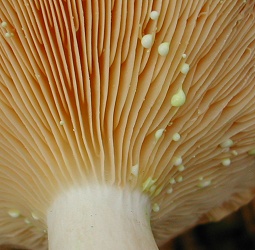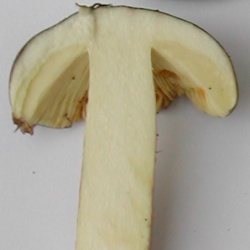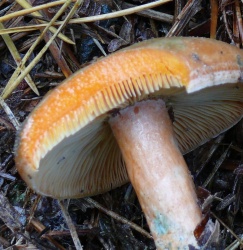question 19: "Milky" droplets appearing when flesh freshly cut
This feature is usually also easy to detect. We just have to cut a piece off the cap and gills, and check whether a liquid oozes from the flesh in the seconds that follow, especially above the gills. This latex is often white coloured, hence the reference to "milk". Sometimes droplets are naturally visible on the surface of gills. Another important identification criterion stands in the colour of this latex, and how it changes colour when put on a handkerchief.
A vast majority of mushrooms does not produce any latex.
The presence of "milk" being characteristic and sure to evidence, we can also here impose this criterion as a mandatory feature in the results output by the identification search engine. For example, if the unknown mushroom obviously produces a white milk, by ticking both "yes : white" and "force selected answer to criterion", we will exclude all mushrooms which do not produced a white latex from the results output by the search engine.
Note : do not confuse this character with the fact that the mushroom may be soaked with water after a heavy rain. In this latter case, the liquid (actually water) that may ooze is transparent and scarce.
Exemples:

|

|

|
||
| Even without bruising the mushroom, we can see droplets of latex on the gills. Their colour being white, we can select here "yes: white" in the form | We can't see any coloured latex appearing in the fresh cut in this example, we can select here "no" in the form | We can see some liquid oozing at the fresh cut of the flesh. Its colour being orange, we can select here "yes : orange to red" |

Return to identification form